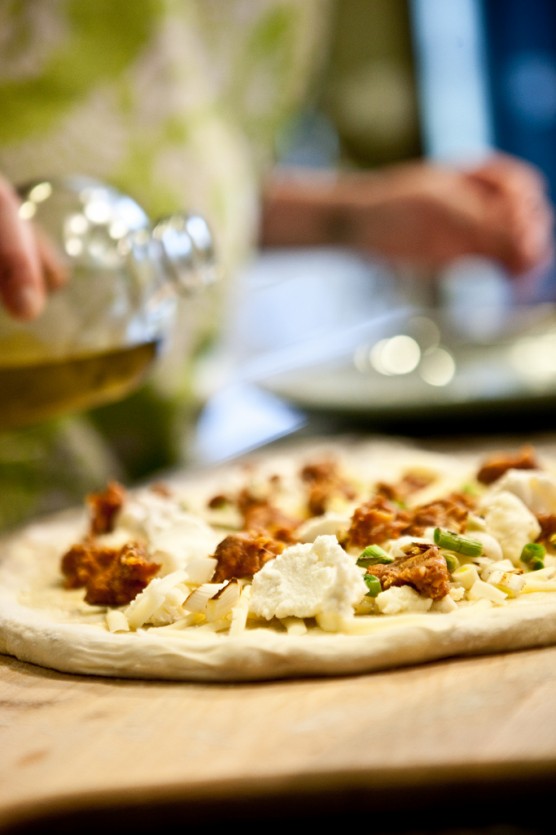Intro

With Delancey (incredible pizza restaurant with famed owners Brandon and Molly – of Orangette) right around the corner from us it seems so silly to even bother making pizza at home. Call me silly. Whenever a challenge presents itself, such as creating crispy, chewy crusted pizza at home, I take it head on and am determined to remove confusion and insert deliciousness.
I recently taught a Spring baking class in which we used pizza as a foundation to highlight some of this season’s finest and brightest offerings. For the sake of the class we researched and tested and scrutinized several crusts. I won’t lie – it wasn’t rough.
We walked away from that evening of testing with full bellies and two pizza crusts that may put Dominos out of business.
My favorite was a crust that was both crispy and chewy yet had a softness that was reminiscent of the fluffy, pillow-like crust my mom used to make. It was salty with a subtle tang that came from taking a few days rest in the fridge.
On top we drizzled olive oil, added mozzarella and fontina and scattered par-roasted asparagus spears. After three minutes of baking in a very hot oven we cracked three eggs on top then waited patiently. The hot pizza was then topped with prosciutto and grated Grana Padana or Parmesan. A light sprinkling of salt dusted the perfect pie which was then quickly devoured.
Beautiful pizza at home – it can be done.

THE Pizza Crust
adapted from 101cookbooks.com
4 1/2 cups all-purpose flour
1 3/4 teaspoons kosher salt
1 teaspoon yeast
1/4 cup olive oil
1 3/4 cups water
Semolina flour OR cornmeal for dusting
Combine all the ingredients. Mix by hand or with a stand mixer fitted with the dough hook. Knead for 5-7 minutes – until soft, quite sticky but not wet.
Cover a baking sheet with parchment and a fine coating of pan spray or oil. Divide the dough into four equal portions then place on the baking sheet. Using a bit of flour if the dough or your hands are very sticky, shape the portions into round balls. Mist the dough with oil or pan spray then cover with plastic wrap.
Place in the fridge for at least one day or up to three days.
Remove the dough 2 hours before you plan on baking. Place the sheet tray in a warm spot in your kitchen.
Pre-heat your oven (if you have a pizza stone pre-heat your oven with the stone inside) to 450* for 45 minutes prior to baking.
With your hands or a rolling pin, shape one of the portioned dough pieces to the desired size and thickness. Place on a cornmeal dusted pizza peel or use the back of a baking sheet. Top with desired toppings and bake until crust is lightly golden and cheese is melted and bubbly.
Note: If you want to save some of the dough for future baking, you can store the dough balls in a zippered freezer bag. Dip each dough ball into a bowl that has a few tablespoons of oil in it, rolling the dough in the oil, and then put each ball into a separate bag. You can place the bags into the freezer for up to 3 months. Transfer them to the refrigerator the day before you plan to make pizza.

This one had mozzarella, fontina, fresh ricotta, green garlic and merguez (lamb sausage)
Pizza Tips
1) Always preheat your oven and pizza stone for 45 minutes prior to baking. Use the hottest setting you can. 500 – 550 degrees in most ovens. Use convection if you have it.
2) Semolina flour makes an ideal dusting flour for your pizza peel so your pizza doesn’t stick and you can easily transfer it from peel to stone. If you don’t have a peel, a cookie sheet can work, but honestly, not as well. Corn meal also works well for dusting.
3) Overnight crust recipes will result in a more flavorful and glutinous pizza, which improves chewiness and crispiness to the crust.
Roasted Asparagus, Egg & Prosciutto Pizza
Olive oil
Roasted asparagus (drizzle with olive oil, salt & pepper and roast for 10 minutes at 400)
2-3 oz fresh mozzarella, torn into nickel size pieces
3 eggs, cracked and waiting in a bowl.
2 oz San Danielle or other high quality prosciutto
high quality sea salt or fleur de sel & fresh cracked pepper
freshly grated Parmigiano
Preheat your oven for 45 minutes with pizza stone inside, to 500 – 550 degrees.
With your dough create 12” round. Place on flour dusted pizza peel. Brush with olive oil and dust with sea salt. Break up fresh mozzarella on top of pizza, add roasted asparagus. Slide onto pizza stone and bake for 3 minutes. Open oven and as quickly as possible pour the eggs onto three different places around the pizza. Bake for another 7 minutes or until golden and eggs are cooked to your liking. We shoot for a semi-soft yolk. Remove from oven and grate Parmigiano over top. Drape 4-5 slices of prosciutto on top of this.










I think we’ve had asparagus on pizza three times this week. I can’t get enough of it.
We are not loosing faith in having an outdoor pizza oven one day. Can you imagine the possibilities?
ok i am now drooling! looks so yummy!
I’ve never made my own pizza dough but you make it seem like I can do it! 🙂 Once I make my pizza dough, I’m going to top with it so much cheese and not share my slice with anyone! 😛
After experiencing the chewy, salty, and flavorful zucchini blossom and anchovy pizza at Pizza Forno in Rome’s Campo di Fiori on my honeymoon nearly five years ago, I’ve been determined to recreate that delicious pizza. Seriously, pizzas that stay in one’s memory that long are few and far between. Last July I was able to recreate it with the toppings, and now I’m on the search for the perfect crust. I will certainly be trying yours soon.
It looks really good, crunchy and soft in the middle. I’m Italian:))
I love your flavoured with roasted asparagus!
It is just delicious.
This pizza looks so good! I also use 101cookbooks recipe, and know it’s a staple. Thanks for the post!
I love homemade pizza, especially in the summer! This is getting starred and saved for future dinners!
Thanks-
Caitlin
Now I know that you’re expecting, and have a family to take care of, but want to hop a plane, cross an international border and make pizzas all day?
I haven’t seen an egg on a pizza since we were in Europe…good memories, and oh so delicious. I will try your pizza crust…always love homemade pizza…we cook outside on the grill. ymmmmm
Some of the food bloggers in Ireland are having an online Twitter pizza party tomorrow (#twizzparty), your post is well timed for us! I read this post this morning and just made the dough and am letting it rest in the fridge until tomorrow night. I’m looking forward to seeing what difference the rest makes.
Sorry, that should have been #twizzaparty!
This sounds fabulous, I’ve tried so many pizza dough recipes in search of the perfect one. Keeping the dough in the fridge for a couple days to develop flavor is a great idea. Thanks for sharing this, can’t wait to try it!
I have spent a long time looking for the perfect crust. To no avail. This is next on my list!
What a gorgeous pizza. My next pizza will be grilled. I have the grill; I have the recipe. Now I just have to find the time.
Cheers!
I normally use the no-knead bread recipe for my pizza crust, but that looks so good, I think I’m going to have to try it out!
I love making my own pizza dough but somehow it doesn’t always work. I’ll give your dough a try. It surely looks scrumptious!
Magda
I have a question about the dough, did you use fresh or dry yeast? Many thanks, Mari
Mari – I used dry yeast.
This pizza looks delicious!!! I love the asparagus and egg toppings — and of course everything is better with prosciutto! Thanks for sharing!
YES! This recipe is very close to what I use. So many recipes skip the step of keeping the dough in the fridge for at least 24 hours, but it is a VERY important step. Pizza dough isn’t something that can be rushed if you want a good result.
I love this recipe, I have tried it out however I used Stilton cheese instead to bring out the flavour in the asparagus. If you haven’t tried Stilton have a look at their blog its full of great ideas.
They have an ex food journalist who writes some of the blogs also, check it out: http://www.stiltoncheese.com/blog
I would love to freeze some of the dough balls for future use — would I freeze them before or after they sat in the fridge for a few days?
Elissa – I’d freeze after letting the dough rise at room temperature for 2 hours. That way the yeast has a chance to feed and start to develop the bread. Believe it or not, yeast activity still happens in the freezer just at a very, very slow pace and stales once completely frozen. So by freezing after the first rise you get a good start on yeast growth but not too much that the dough takes on too much sourness.